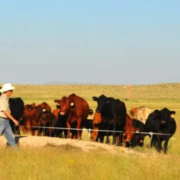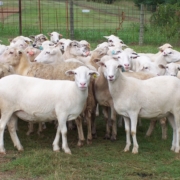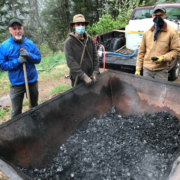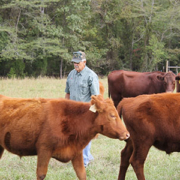Weaning Pasture Soils Off Chemical Dependence
 Print This Post
Print This Post
By Lee Rinehart, NCAT Agriculture Specialist
I recently received an email from a farmer in New England. They have put a lot of effort into their beef farm to bring their soil to life after decades of conventional corn and hay production with substantial chemical inputs. They have been working to improve the health of their pasture soils by overseeding with clover and rotationally grazing and have begun a regime of applying organic amendments to help stimulate microbial activity. In their words, they are “weaning their soils off chemical dependance,” even if at times they feel like they are “shooting in the dark.”
I feel that way a lot. Shooting in the dark. Many of my consultations with farmers and graziers over the years have taken on this quality. But really, what is happening is we are having a conversation about a complex living ecosystem that we barely understand. What I have learned is that good grazing comes from experience. And experience is informed by observation and science.
For this most recent conversation, we started off with the idea of kick starting the soil biological community. The single most beneficial way to do this is to increase soil organic matter. After all, it is what soil bacteria eat. This is the best way to build aggregate stability and lower soil bulk density. It turns the soil from a brick to a sponge. A good way to do this inexpensively is bale grazing with livestock in high density for a short period of time, somewhere above 100,000 pounds of live weight per acre (this is highly variable). Bale grazing is an excellent way to build soil over time and is especially useful on pastures in the dormant season or for renovating poor performing fields during the grazing season. An intentional, planned disturbance of short duration with a long rest period for full plant recovery disturbs the soil surface with hoof action, pushes plant residue close to the soil surface for rapid decomposition, and distributes manure and microorganisms from the animals’ saliva and haircoat. Think of it as biological priming for soils.
Sometimes a grazier will ask about planting improved species. After all, when they look across their fields they see a scattering of annual forbs, perhaps the resilient stalks of perennial weeds, and short, closely cropped perennial grasses holding on for dear life. It makes sense, though, to think about planting better grasses. The logic is sound. But I have learned that this seldom works and can be extremely expensive. For success, it just about means farming the field… some kind of tillage, weed control, fertilizer, and water. And it takes time. A grazier can drain their savings account in one season farming this way. Farming is risky enough without adding to our debt load.
Then I learned how many seeds are just sitting in the soil, waiting for the opportune time to emerge. Sure, there are lots of weed seeds. These are often the first to emerge and they do this for a reason. The annuals come up and provide soil cover, a band aid, the first step in healing damaged soil. But this is the time to use animal impact and see if we can release the native seedbank and get the good stuff to emerge.
For the beneficial grass and forb seeds to germinate and grow, we need disturbance. But I don’t mean tillage, I mean the kind of disturbance I described above. Getting organic matter into the soil will help to increase water infiltration, it will make mycorrhizal fungi and bacterial populations explode in numbers. It will create aeration, little passages in the soil for air and water to pass through.
I was talking to Allen Williams a few weeks ago, and he mentioned something that made me think. These little channels, caused by soil aggregation, earthworms, and dung beetles, provide a passage for deeply buried seeds to travel up closer to the soil surface where they can germinate. Think about it… when water infiltrates, the seeds that are buried deep in the soil profile have a route to float up and get within the germination zone. Perhaps this explains what I have seen after a few years of grazing with thoughtful disturbances – fields that become highly diverse and productive with plants I didn’t even know were present in the seedbank.
So that’s one way to establish a better forage stand. Another approach that graziers have been using for years is frost seeding. Remember, frost seeding is when we broadcast a small seeded species in the late winter when the soil is undergoing a sequence of freezing at night and thawing in the day. This action serves to pulse the soil surface ever so slightly to help cover small seeds with soil over the course of a few days or weeks, allowing them to germinate when the temperature gets to around 60°F. Red clover works well for this, as does white clover and many other small seeded legumes. Grass seeds are larger and, because of this, frost seeding is seldom recommended for establishing grass stands, though I know people who have tried it. If you are making your frost seed decision late, you can perhaps mimic the freeze-thaw action by turning livestock into the pasture after broadcasting seed and let them trample it in.
Some other things came to mind as I was talking to this grazier, logistical things to help ensure their animals could provide the impact they needed them to perform when they needed it. One was to ensure their watering systems are portable to give more control of paddock use. It is much easier to time the grazing and rest periods of paddocks when water access is not an issue. Another is to use polybraid and step-in posts to strategically enclose paddocks and try to match herd weight (the herd dry matter intake requirement) with the forage available. As a rule, I have adapted the old adage “take half leave half” to “take half trample half.” The ATTRA publication Paddock Design, Fencing, Water Systems, and Livestock Movement Strategies for Multi-Paddock Grazing goes into detail on water and fencing, so I’ll direct you there if you’d like more on these and other logistical concerns.
Finally, make grazing decisions based on observation of impact on previous fields and the needs of the current field based on goals (animal productivity, weed pressure, renovation, need for incorporating organic matter, going on vacation, etc.). And try not to re-graze a field until the plants have fully recovered. This is the cardinal rule in grazing. And never do the same thing on a paddock season after season and year after year. Nature is fickle and changes things up regularly. Mimicking nature in this way opens the opportunity for various things to happen, from new forages appearing in the fields to providing wildlife habitat for ground-nesting birds. Change it up, observe what happens, and try to capitalize on nature’s methods.
Getting off chemical dependance, and in this case synthetic fertilizer, is achievable in pasture systems. Instead of ammonium nitrate, we rely on nitrogen from mineralization and legumes. Soil aggregation is key. After the soil has begun to wake up and nutrient cycling is running at optimum, you can start the weaning process. I like to recommend Christine Jones’s regime for doing this: 20% reduction in the first year, followed by two years of additional 30% reduction, culminating with two years of minimal applications of about 4.5 pounds per acre to jump-start the grazing season. Many have gone cold turkey and it has worked. But those graziers have been doing regenerative soil management for decades. My advice is to add organic matter, build aggregation, and go off fertilizer slowly.
Related ATTRA Resources:
Toolkit: How to Reduce Synthetic Fertilizer Use
Adaptive Grazing – You Can Do It
No-Till Farmer
Other Resources:
Healing Battered Fields, Pastures with Adaptive Grazing
This publication is produced by the National Center for Appropriate Technology through the ATTRA Sustainable Agriculture program, under a cooperative agreement with USDA Rural Development. ATTRA.NCAT.ORG.





 Courtesy
Courtesy



 NCAT
NCAT